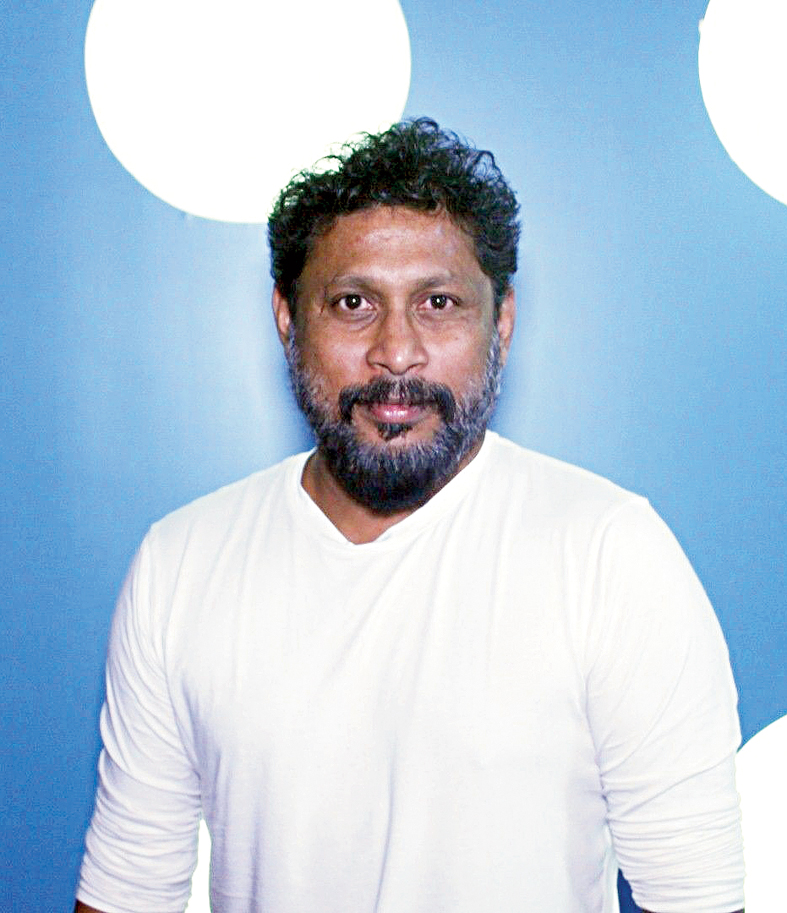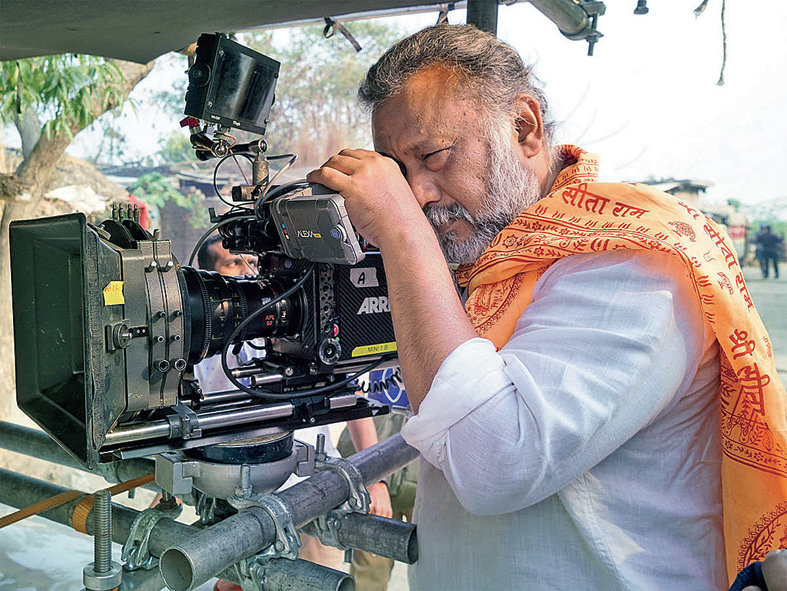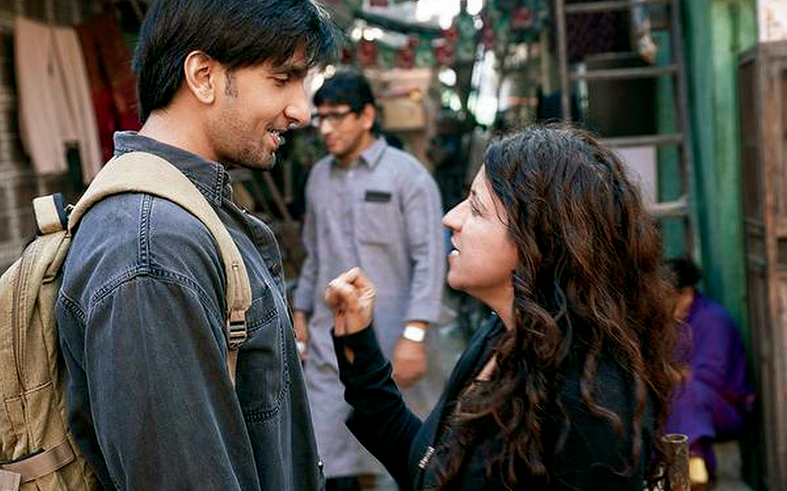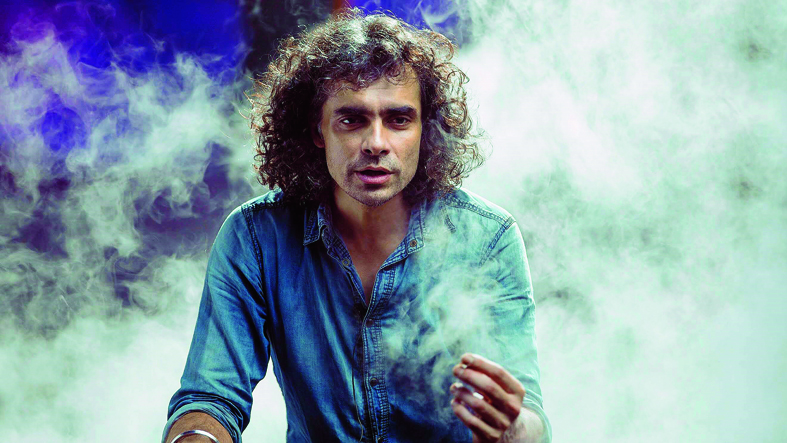
Shoojit Sircar Sourced by the Telegraph
Rajkumar Hirani
Bollywood’s Mr Dependable. Combines content with commerce with a 10/10 track record, both at cash registers and in the hearts of the audience.
Top outings: Munna Bhai MBBS (2003), Lage Raho Munna Bhai (2006), 3 Idiots (2009), PK (2014), Sanju (2018).
Standout film: Lage Raho Munna Bhai, for delivering a series of messages with a jhappi, even as it made Gandhigiri cool.
Strength: The ability to make a socio-political comment working within the tenets of a Bollywood entertainer. His films deliver a message but never hammer it in. Motifs and memorable lines are a given in Raju Hirani style — ‘jadoo ki jhappi’ to ‘aal is well’ to ‘wrong number’.
Weakness: There’s little to fault in Hirani’s film-making, but Sanju — despite being his biggest blockbuster — revealed fault lines in the way it blindly whitewashed its protagonist, painting a portrait of actor Sanjay Dutt that wasn’t always digestible.
Opportunity: His mind — and writing — travels to places where few others can. Who else could have thought of depicting the ineffectuality of religious practices through the eyes of an alien like in PK? Or just make the teachings of the Mahatma relevant once more as in Lage Raho Munna Bhai?
Threat: In a business that throws up new talent every Friday, Hirani hasn’t announced a film after Sanju.

Rohit Shetty with Akshay Kumar and Katrina Kaif, who star in his upcoming biggie Sooryavanshi Sourced by the Telegraph
They have created their own genres in Bollywood and have helmed the most memorable films coming out of the industry in recent times. Priyanka Roy delves into the works of 10 film-makers

Anubhav Sinha Sourced by the Telegraph
Vishal Bhardwaj
The director with a distinctive voice started out as a music man, but is today one of the country’s most celebrated film-makers. Bhardwaj may have explored varied genres and subjects but his greatest achievement, so far, has been in introducing (and reintroducing) Shakespeare to the desi audience.
Top outings: Maqbool (2003), Omkara (2006), Kaminey (2009), Haider (2014).
Standout film: Omkara. Othello’s desi spin was a remarkable piece of film-making, almost playing out like a Greek tragedy. Both violent and visceral, Omkara gave us memorable moments and even more memorable characters (Langda Tyagi is legend).
Strength: Just in the way he presents his stories, no-holds-barred and in his inimitable style. Visual storytelling is VB’s strength and his stories are distinguished in the way they are rooted in the Indian ethos even as they speak about global scenarios and issues. He excels in bringing flawed characters to screen, and telling their stories of redemption and catharsis.
Weakness: His inherent quirkiness sometimes gets the better of him. Case in point, Matru Ki Bijlee Ka Mandola. Also, his films are not for everyone.
Opportunity: For an audience thirsting for rarely-told-before content more than ever after being exposed to international content on streaming platforms, thinking film-makers with fresh ideas, like Bhardwaj, have the opportunity to simply fly. Also, he has resisted been boxed in and that works in his favour.
Threat: Bhardwaj takes time to get his projects off the block, in contrast to his contemporaries who churn out films with alacrity.

Zoya Akhtar with her Gully Boy man Ranveer Singh Sourced by the Telegraph

Sanjay Leela Bhansali with Deepika Padukone, who has starred in his last three films Sourced by the Telegraph

Anurag Kashyap Sourced by the Telegraph

Sriram Raghavan Sourced by the Telegraph
Shoojit Sircar
With his slice-of-life films that winningly combine message with mirth, Shoojit has brought the common man (and woman) into focus in Bollywood, telling tales about you and me, for you and me.
Top outings: Yahaan (2005), Vicky Donor (2012), Madras Cafe (2013), Piku (2015), October (2018).
Standout film: Piku, a film that had so much to say — a woman’s right to independence to our duty towards ageing parents — but wrapped it all in an entertaining slice-of-life film that made us chuckle and cry.
Strength: His ability to churn out cinema out of the commonplace. Mostly aided by the pen of Juhi Chaturvedi, Shoojit has consistently pushed the envelope as a film-maker and doesn’t shy away from diving into sticky (and icky) stories, sperm donation to constipation. Also, few could have explored grief as sensitively as he did in October.
Weakness: His films — October is a case in point — can sometimes meander, but that’s nitpicking. Probably needs to be seen and heard more, a given these days in an industry that’s so competitive and where memories are consistently short.
Opportunity: In taking his latest film Gulabo Sitabo — starring Amitabh Bachchan and Ayushmann Khurrana — direct to digital, Shoojit has bravely (and with huge foresight) paved the way for an all-new alternative to theatrical releases. Perhaps this is the right time to push and release his long-stuck-in-the-cans Bachchan starrer Shoebite on the web?
Threat: Will opportunity turn into a threat? Will Shoojit’s decision to release Gulabo Sitabo digitally affect the theatrical release of his next films, particularly the made-for-big-screen Sardar Udham Singh, with Vicky Kaushal in the title role? Let’s hope not.
Sanjay Leela Bhansali
The auteur whose every frame spells movie magic. All his films have a beating heart underneath the glitz and grandeur.
Top outings: Khamoshi (1996), Hum Dil De Chuke Sanam (1999), Devdas (2002), Black (2005), Ram-Leela (2013), Bajirao Mastani (2015), Padmaavat (2018).
Standout film: Black. For the way in which he subverted Bollywood tropes — a physically impaired protagonist, an unconventional ‘love story’, trading bright frames for dark tones — in this profound and powerful film starring Amitabh Bachchan but truly frontlined by Rani Mukerji.
Strength: Romance in all its hues — passion and pain, pride and prejudice — is a Bhansali trademark. His film-making is both epic and intimate. Few can mount a film as dazzlingly as Bhansali does. Is brave enough to see his projects through controversy or commercial constraints.
Weakness: Hardly ventures beyond a given framework. History intrigues him and that’s where he largely operates.
Opportunity: In a post-Covid-19 scenario where big productions will be few and far between, Bhansali has the window to go back to the drawing board and show us that he can still make love stories without having to coat them in gold and silver.
Threat: The drying up of film-making budgets is a given in the next few months. Bhansali’s opulent sets of Gangubai Kathiawadi, starring Alia Bhatt, have already been pulled down in Mumbai’s Film City after shooting came to a halt.
Anurag Kashyap
The man who gave the Bolly audience a taste of India as it truly is, travelling to the desi hinterland — and heartland — to consistently churn out raw, visceral experiences that pack a punch. After his mentor Ram Gopal Varma, Kashyap is the maker of some of the most seminal gangster films in this country. He, of course, makes them better.
Top outings: Black Friday (2007), Dev.D (2009), Gangs of Wasseypur I & II (2012), Mukkabaaz (2018), Manmarziyaan (2018).
Standout film: The Gangs of Wasseypur films. Like every gangster film, it had its share of guns and goons, angst and abuse, but Kashyap excelled in giving the two-part film a strong emotional core.
Strength: Realism made its way into Bollywood through Kashyap. Operating on its fringes for many years, Kashyap, with his innate ability to turn ordinary moods and moments into something extraordinary on screen, is now an indelible part of mainstream Bollywood. He has, however, not lost his indie voice, and almost always makes a statement, no matter what film he’s helming. He also backs projects full-on, regional cinema included, and has been largely responsible in taking our films to the global stage.
Weakness: Has come to be identified with a certain kind of film and film-making. As a producer, he may have backed every kind of film, but Kashyap hasn’t really deviated — apart from a Mukkabaaz or Manmarziyaan — into delving into diverse genres as a director. Also, needs to channel his angst more productively sometimes.
Opportunity: Manmarziyaan, an offbeat romance told in a fresh and feisty way, showed that Kashyap is a rare storyteller who can tell every kind of story, if he wants to. Also, his transition into web early — Sacred Games is, of course, seminal — means he has a head start over his contemporaries in the space.
Threat: His anti-establishment political opinions often tend to cloud the perception of and reception to his projects.
Zoya Akhtar
The only woman on this list has a voice that breaks through the clutter, whether it’s in telling stories of heartbreak in swank high-rises or the crushing of dreams in cheek-by-jowl slums.
Top outings: Luck By Chance (2009), Zindagi Na Milegi Dobara (2011), Dil Dhadakne Do (2015), Gully Boy (2019).
Standout film: Luck By Chance. It had a certain honesty in holding up a mirror to films and film stars, even as it illustrated the fickleness of friendships and loyalties in the business. We also pick Zindagi Na Milegi Dobara for exploring carpe diem in a way few Bolly films have done.
Strength: The ability to tell stories straight from the heart and often, from the gut. Her films have a sense of relatability because they talk about basic emotions. Has strong film-making skills, an eye for detail, knows how to mount her films and ensures that almost all of them are spoken about, even years down the line.
Weakness: ‘Zoya can only make films about the rich’ was something that was thrown at her frequently. But she silenced them all with Gully Boy, a rebel anthem from the streets that spoke about the marginalised. Now, Zoya needs to expand her repertoire beyond telling relationship stories.
Opportunity: She smartly expanded to the web — the smash-hit Made in Heaven and Lust Stories to the not-so-successful Ghost Stories — quite early, something that will work in her favour in a post-Covid-19 world.
Threat: Till a few years ago, Zoya was, perhaps, one of the few ‘woke’ film-makers in Bollywood. Now there are more. As also many, many more women directors. But is that a threat or the opening up of more opportunities for women, including Zoya?
Anubhav Sinha
Anubhav Sinha has scripted the biggest turnaround story in the last few years, going from making average masala movies to his recent outings, all of which make a statement, either subtle or with a sledgehammer. Sinha is today the most ‘woke’ film-maker in Bollywood
Top outings: Mulk (2018), Article 15 (2019), Thappad (2020).
Standout film: Article 15. The searing look at the ugly underbelly of class-driven politics was a punch to the gut and a gutsy expose of caste discrimination.
Strength: Sinha, in his recent films, has pulled no punches and hit where it hurts. His films touch upon everything from marginalisation to domestic violence and are both soul-searching and hard-hitting. Is, perhaps, a rare ‘feminist’ male film-maker in Bollywood.
Weakness: Has blossomed late as a film-maker, with his contemporaries — he counts fellow film-makers Hansal Mehta and Shoojit Sircar as his closest friends — having made far more meaningful films than he has.
Opportunity: Sinha is a well-rounded film-maker — he can churn out both a big-budget spectacle like Ra.One and intimate, raw films like Mulk and Thappad.
Threat: Puts his money where his mouth is and in a country that’s always ready to outrage, his films are constantly in danger of feeling the heat.
Sriram Raghavan
The master of the modern thriller. The man who exemplifies edge-of-the-seat storytelling. Sriram Raghavan brings a delicious twistedness to his plots and players, and yet manages to make them relatable.
Top outings: Ek Hasina Thi (2004), Johnny Gaddaar (2007), Badlapur (2015), Andhadhun (2018).
Standout film: Andhadhun. Raghavan’s most recent thriller is a masterclass in the genre, playing hide-and-seek with the audience even as it makes the viewer a privy to its twists and turns.
Strength: His mind travels to places unconventional. His whodunits are more ‘howdunits’, delving into the mind and mechanics of crime and criminals, and keeping the viewer guessing at every point. His films are as much a commentary on human flaws as they are fast-paced thrillers. He also knows a thing or two about tempering taut and thrill with wry wit.
Weakness: Has made far less films than he should have.
Opportunity: Raghavan has few rivals — apart from Sujoy Ghosh and Neeraj Pandey — in the genre he excels in. For a newly evolved Indian audience now consuming a lot more cutting-edge international content, Raghavan’s intelligent writing and canny techniques should stand him in good stead.
Threat: With the web delving into every genre, including thrillers, Raghavan perhaps needs to adapt to different mediums. Neeraj Pandey did that successfully with Special Ops.
Rohit Shetty
He blows up cars in his films. His fims, in turn, blow up the box office. Rohit Shetty is Bollywood’s Mr Hit Machine. His film-making may be far from solid but when it comes to having a finger on the pulse of his audience, Shetty rarely puts a foot wrong.
Top outings: Golmaal: Fun Unlimited (2006), Singham (2011), Bol Bachchan (2012), Chennai Express (2013), Simmba (2018).
Standout film: Singham. Benefiting from a strong central act from Ajay Devgn, Singham made the common cop a hero. Some of it may have been tone deaf, like many of Shetty’s other films, but there’s no denying that Singham packed a punch.
Strength: Entertainment. Entertainment. Entertainment. Shetty’s films deliver the big ‘E’ in spadefuls. He knows exactly what works with an audience that sustains itself on a steady diet of Bolly commercial cinema and promises a paisa-vasool time at the movies.
Weakness: He may be huge at the box office but his films aren’t necessarily well made, promoting everything from sexism to vigilantism.
Opportunity: If there is one man who can get audiences back to theatres after this phase, then it’s Shetty. Sooryavanshi, starring Akshay Kumar and Katrina Kaif with power-packed appearances by Ajay Devgn and Ranveer Singh, is what Bollywood needs to lure people back into theatres. He’s also poised at the cusp of creating his own cinematic universe with Singham, Simmba and Sooryavanshi joining forces, something that could translate into many more blockbusters.
Threat: Can he ever make a low-budget film with intimate storytelling? Shetty is yet to prove that.

Imtiaz Ali Sourced by the Telegraph
Imtiaz Ali
The man at the helm of some of the most sublime romances. Love, in all its shades, defines the core of Imtiaz Ali’s film-making. His last two films may have ranged from trite to trash, but when it comes to romance, few can do it the way Imtiaz can.
Top outings: Socha Na Tha (2005), Jab We Met (2007), Love Aaj Kal (2009), Rockstar (2011), Highway (2014), Tamasha (2015).
Standout film: Jab We Met. Imtiaz’s later films — Rockstar to Tamasha — may have been superior in terms of film-making but Jab We Met is our pick because it ticks all the boxes needed to ensure a feel-good watch. Plus, it’s a film that’s aged well.
Strength: The pain and pleasure he brings to romance. This is a man who can create magical moments on screen, whether it’s an angst-filled Jordan losing it on stage in Rockstar or a beleaguered Ved dropping his head on the table after fighting the world in Tamasha. Plus, of course, is his ear for music.
Weakness: Isn’t consistent. Seems to have lost his mojo for a bit, if the mostly unwatchable Jab Harry Met Sejal and the dull rehash of Love Aaj Kal are any indication.
Opportunity: This is the perfect time for Imtiaz to do some much-needed introspection and go back to the drawing board. He still remains the king of romance but now needs to expand within its tenets as well as venture into different genres.
Threat: Two back-to-back duds, both mediocre films, isn’t great news at a time when most of his contemporaries are whipping up fresh ideas.











